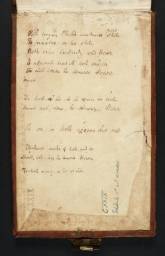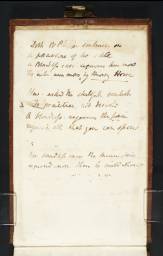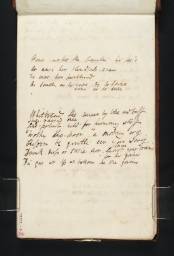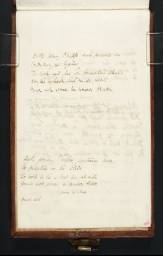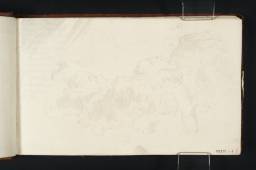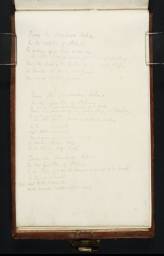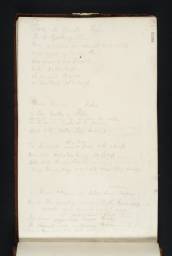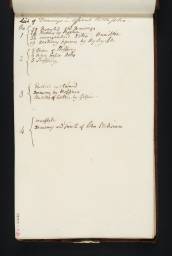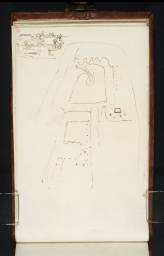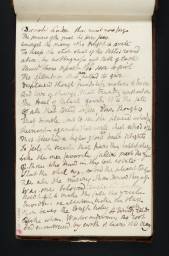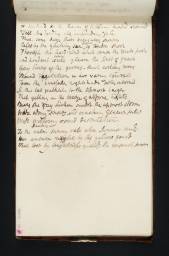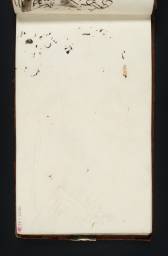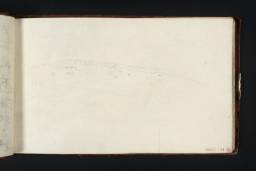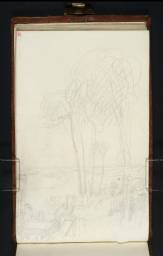Turner Bequest CXXIX
Sketchbook, bound octavo in leather with an embossed scroll motif down the spine edge, with a brass clasp attached to the outside edge of the front cover and a brass catch plate to the outside edge of the back
123 leaves of thin white wove paper, and inside covers
Approximate page size 110 x 178 mm
Watermarked ‘J WHATMAN | 1805’
Bookseller’s label inside back (apparently original front) cover (see main catalogue entry)
Turner’s label on spine inscribed in ink ‘65’, noted by Finberg, is no longer present
Inscribed by an unknown hand in pencil ‘S42’ on front cover
123 leaves of thin white wove paper, and inside covers
Approximate page size 110 x 178 mm
Watermarked ‘J WHATMAN | 1805’
Bookseller’s label inside back (apparently original front) cover (see main catalogue entry)
Turner’s label on spine inscribed in ink ‘65’, noted by Finberg, is no longer present
Inscribed by an unknown hand in pencil ‘S42’ on front cover
Accepted by the nation as part of the Turner Bequest 1856
References
The sketchbook was named by Finberg on the grounds that one sketch, folio 47 (D09123), served as the basis of a watercolour dated 1813 of Woodcock Shooting on the Chevin (Wallace Collection, London).1 Four further sketches, folios 22, 40 verso, 48 and 49 (D09085, D09115, D09124, D09125), record scenes in the neighbourhood of Farnley Hall near Otley, the home of Turner’s patron Walter Fawkes.2 The majority of the sketches, however, consist of studies for upright classical compositions, some of which appear related to paintings of Mercury and Herse (on the London art market in 2005)3 exhibited in 1811 and Crossing the Brook (Tate N00497)4 exhibited in 1815. Gerald Wilkinson notes that the title is misrepresentative of the wider contents, but speculates that the classical compositions might have been a wet-day occupation for Turner at Farnley. Apart from the classical compositions the remaining material is more than a little miscellaneous.
Three studies, folios 14 verso, 51 verso and 122 (D09075, D09128, D09204), rehearse designs for Sandycombe Lodge, the small villa at Twickenham that Turner designed for himself and had built c.1812–13.5 There are various drafts of poetry. A scheme for a picture hung in Turner’s Gallery appears on folio 45 (D09121) and a list of intended works on folio 4 (D09063). Two potentially important sketches, folios 104 verso, 105 verso (D09182, D09184) depict a large river oxbow as yet unidentified. There is a study of a nude, not altogether academical, folio 116 verso (D09198) and a study, folio 41 (D09116), for the painting Apullia in Search of Appullus (Tate N00495)6 exhibited at the British Institution in 1814. Turner seems to have used the sketchbook as no more that a jotting book and used less than a quarter of the total number of pages available. There are arbitrary intervals of blank pages, and an uninterrupted sequence of fifty-one blank pages towards the centre, amounting to nearly half the book in total.
The reading of the sketchbook is further complicated by the fact that the pages appear to have been numbered in reverse. Approaching the book from the outside it has one brass clasp. A right-handed person would handle the sketchbook with the spine to the left, and the clasp to the right, with the clasp itself attached to the back cover and clipped on to a catch plate attached to the front cover. The book would be opened by sliding the clasp from left to right with the right thumb. That logic is supported by the position of the bookseller’s label, on what must originally have been the inside front cover. Given, however, the relative arbitrariness of the sketches apart from the sequence of classical compositions, the early cataloguers of the Turner Bequest numbered the book starting at what must originally have been the back cover.
The reading of the sketchbook is further complicated by the fact that the pages appear to have been numbered in reverse. Approaching the book from the outside it has one brass clasp. A right-handed person would handle the sketchbook with the spine to the left, and the clasp to the right, with the clasp itself attached to the back cover and clipped on to a catch plate attached to the front cover. The book would be opened by sliding the clasp from left to right with the right thumb. That logic is supported by the position of the bookseller’s label, on what must originally have been the inside front cover. Given, however, the relative arbitrariness of the sketches apart from the sequence of classical compositions, the early cataloguers of the Turner Bequest numbered the book starting at what must originally have been the back cover.
Despite that recognition, no real thread to the sketches presents itself. The sketches oriented towards the back (originally the front) cover are randomly and widely dispersed. The first page in the sequence, folio 122 verso (D09205), features some lines on the ‘Vale of Tempe’ and this is followed on the recto (D092404) by a study of a chimneypiece for Sandycombe Lodge. Then come several blank pages, a watercolour nude, folio 116 verso (D09198), more blank pages, some arithmetic, folio 106 verso (D09186) and the aforementioned sketches of a river oxbow. Next come fifty-one blank page-spreads before a design for Sandycombe Lodge, folio 51 verso (D09128), a study for Apullia in Search of Appullus, folio 41 (D09116) and a drawing of Otley Bridge, folio 40 verso (D09115), until one arrives at the opposite cover with several pages of verses. It is clear enough, however, from the orientation of the inscription inside the cover that the verses were begun inside what Turner considered to be the back cover.
Following the numbered sequence, the sketches and notes occupy folios 3 and 4 (D09062, D09063) between the inscriptions, before giving way to several blank spreads interspersed with a plan of the garden at Sandycombe, folio 14 (D09074) and some verses, folios 17 and 18 (D09078, D09079). After this there are several more blank spreads before the sequence of classical compositions runs intermittently from folio 21 verso (Tate D09084) to 52 (D09129). Interspersed amongst the classical compositions is a distant view of Farnley, folio 22 (D09085), some more verses, folios 43 verso–44 (D09119–D09120), a plan for the hang of Turner’s Gallery, folio 45 (D09121), and three sketches on Otley Chevin, folios 47–49 (D09123–D09125). With the exception of the series of classical compositions, the intervals of blank pages make it difficult to be certain that sketches with a similar orientation imply any determinable relationship or order of entry. Despite the recognition that the book is actually numbered in reverse, therefore, it would achieve almost nothing to attempt to reverse or renumber the sequence here. The listing below accordingly follows Finberg’s numbering.
There is no definitive evidence for dating the book, but a certain amount from which one might infer. The paper is watermarked 1805 but Finberg found ample evidence for later usage and suggested c.1810–12. The evidence below tends to favour a dating at the end of this bracket and perhaps into 1813. Finberg did not give a detailed rationale for his dating, but it would appear that one element was the evident relationship of the first classical compositions, folios 20 verso and 21 (D09082, D09083) to Mercury and Herse exhibited in 1811. Although there is undoubtedly some similarity of general composition, the connection is not close enough to establish a preparatory relationship. Rather, it is argued here, Turner used the general composition of Mercury and Herse as a departure point for a series of themes and variations, concluding by approaching his next exhibited upright classical composition, the 1815 Crossing the Brook. If we discount any certain temporal relationship to Mercury and Herse then we must look elsewhere for a reference point, the most definitive being the sketch of Otley Chevin, folio 47 (D09123), which formed the basis of the watercolour of Woodcock Shooting on the Chevin. The watercolour is dated 1813, providing a terminus post quem for that sketch at least. So with no immediate reason to suspect any great interval between the making of the sketch and the dating of the watercolour, we might look to the summer/autumn of 1812 (or at the very latest the autumn of 1813) for the date of the sketches in the neighbourhood of Farnley Hall.
Another group of sketches is related to the building of Sandycombe Lodge. The house was complete by July 1813 for Turner paid rates from that date. It is not a large house, and should not have taken much more than six months to build. Although we have no more precise detail, it seems a reasonable supposition that construction was undertaken during the last quarter of 1812 and first of 1813. One sketch, folio 51 verso (D09128), shows Turner still considering radically different designs for the building although in one of the designs on that page he approaches the form of the building as realised. At the very least we can say that the sketch must have preceded the commencement of building work, so we might infer a date before the last quarter of 1812. However two other studies, a design for a chimneypiece, folio 122 (D09240) and a plan of the garden, folio 14 verso (D09075), suggest a date close to or even after the commencement of building when Turner was thinking about finishing touches.
One quite specific point of reference may be gleaned from the draft verses that begin on folio 1 and the inside front cover (D09058–D40818) and continue through folio 2 and verso to 7 to 6 verso (D09059–D09060, D09061, D09067–D09066). These elaborate themes around a liaison between ‘Howe’ and ‘Phipps’; Baroness Howe of Pope’s Villa, Twickenham and Jonathan Wathen Phipps, oculist to George III, who were married on 1 October 1812. From what can be understood of Turner’s meaning, the union caused something of a scandal. In any case the marriage supplies at least one precise historical reference that conforms well to the few other clear references in the sketchbook.
Another chronological indication is given by the sketch on folio 41 (D09116) which is very closely related to the painting of Apullia in Search of Appullus. The painting was finished by January 1814 when Turner submitted it to the British Institution, but it is not known when he began work on it. This sketch is so close as to be certainly preparatory to the painting, and given that Turner must have worked on the painting in 1813, a date of that year is suggested.
Two other references in the book provide chronological information, but equivocally. A list of proposed pictures on folio 4 (D09063) includes a reference to the 1813 watercolour of Woodcock Shooting on the Chevin. That would suggest a date of c.1812–13 for the list, but there is no further guidance in it. It is possible that the first item cited, ‘Snow Storm’, might be the painting Snow Storm: Hannibal and his Army Crossing the Alps (Tate N00490)7 exhibited at the Royal Academy in 1812. However, tempting as that identification might seem, it presents some problems for dating the list to c.1812–13 since the pictures are cited in anticipation with a single exception, no.4 ‘Tempest P’ which is listed as ‘Done’. Any identification with Hannibal should therefore be treated with circumspection. Other snow and ice scenes in the same list are not identifiable with any known compositions, although in view of the more certain chronological indications in the sketchbook the wintry subject-matter might indicate Turner thinking his way towards the composition of the oil painting Frosty Morning (Tate N00492)8 exhibited at the Royal Academy in 1813.
A date of c.1812–13 therefore seems to cover most eventualities. In that light the sketch on folio 45 (D09121) is provoking. Turner is clearly considering the arrangements for a hang of pictures in his own gallery at Queen Anne Street. Snow Storm: Hannibal and his Army Crossing the Alps exhibited at the Academy in 1812 is clearly indicated as are Ivy Bridge Mill, Devonshire (private collection)9 and a number of other Devon subjects known to have been exhibited at Turner’s Gallery the same year.10 It seems eminently possible that the sketch records exhibits at the gallery in 1813, but we know almost nothing of his exhibitions there either that year or in 1814.
Andrew Wilton, The Life and Work of J.M.W. Turner, Fribourg 1979, p.361 no.534, as ‘Woodcock shooting on the Chiver’.
See James Hamilton, ‘Fawkes, Walter Ramsden (1769–1825)’, in Evelyn Joll, Martin Butlin and Luke Herrmann (eds.), The Oxford Companion to J.M.W. Turner, Oxford 2001, pp.103–5.
Martin Butlin and Evelyn Joll, The Paintings of J.M.W. Turner, revised ed., New Haven and London 1984, pp.80–2 no.114, pl.122; Sotheby’s sale, London, 5 July 2005, lot 40.
Technical notes
How to cite
David Hill, ‘Woodcock Shooting sketchbook c.1812–13’, sketchbook, October 2008, in David Blayney Brown (ed.), J.M.W. Turner: Sketchbooks, Drawings and Watercolours, Tate Research Publication, September 2014, https://www

